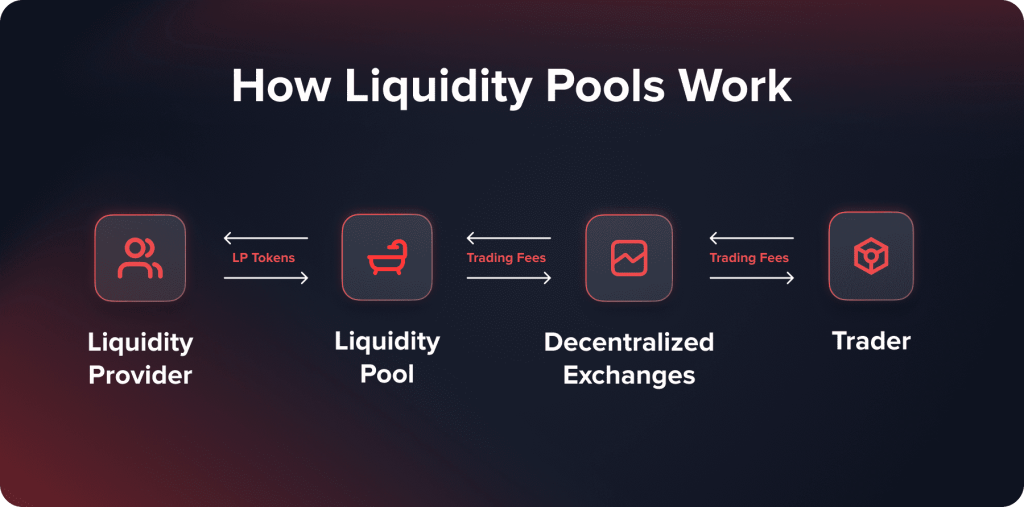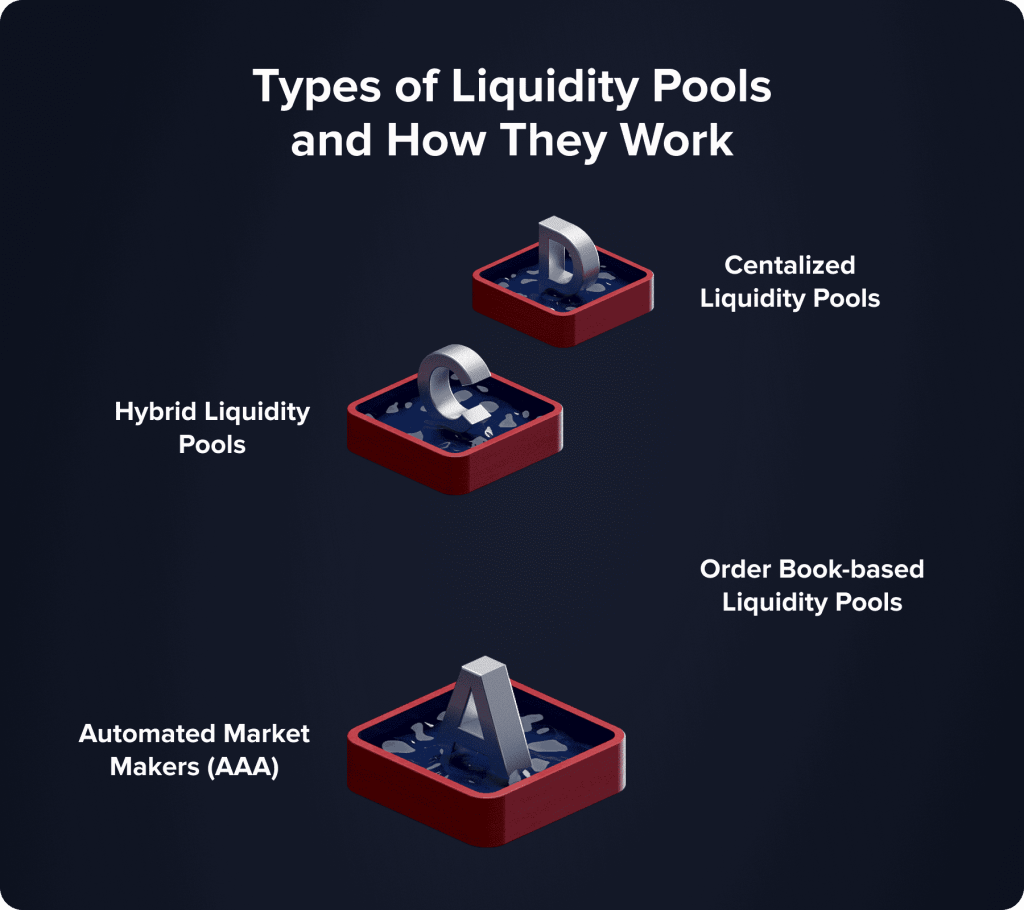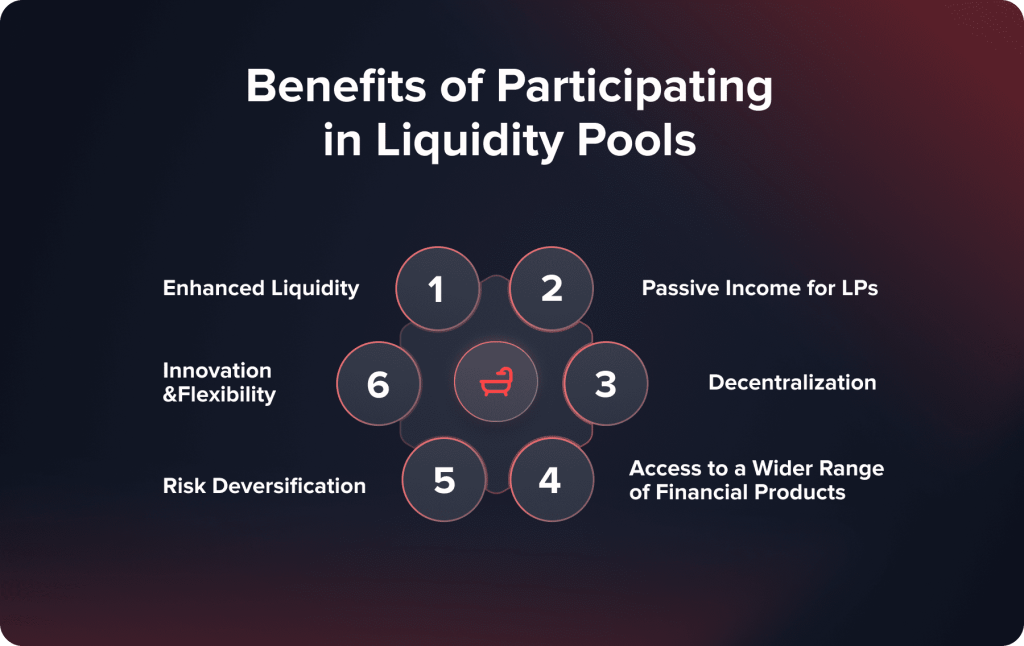
Что такое пулы ликвидности? Определение, типы и преимущества
В статье
В сфере финансов (DeFi) пулы ликвидности помогают пользователям проводить финансовые транзакции без зависимости от традиционных посредников. Эти пулы содержат средства, замороженные в смарт-контракте, обеспечивая ликвидность для бирж (DEX), кредитных платформ и других DeFi-приложений. Для работы в среде DeFi необходимо понимать, как работают пулы ликвидности.
Определение пулов ликвидности
Пулы ликвидности, управляемые сообществом, представляют собой токены или криптовалюты, хранящиеся в смарт-контракте. Предоставляемая ими ликвидность позволяет проводить транзакции, тем самым поддерживая биржевую торговлю. Финансовый рынок ликвидность поддерживается производителями которые покупают и продают активы для упрощения торговли. Пулы ликвидности в DeFi снижают потребность в посредниках, позволяя пользователям вносить свои активы в пул, тем самым превращая их в поставщиков ликвидности.
Крупные финансовые организации, известные как поставщики ликвидности, обычно держат большие объёмы активов для упрощения торговли. Маркет-мейкеры зарабатывают, покупая активы по заниженным ставкам и продавая их по более высоким. Такая конфигурация гарантирует, что всегда найдётся желающий купить или продать актив, тем самым сохраняя ликвидность рынка.
Напротив, подход DeFi демократизирует эту систему. Внося свои активы в пул ликвидности, любой владелец криптовалюты может выступать поставщиком ликвидности (ПЛ). Эти пулы управляются смарт-контрактами — самоисполняемыми соглашениями, непосредственно прописанными в коде. После включения активов в пул смарт-контракт автономно выполняет транзакции и распределяет комиссии между ПЛ в зависимости от их вклада.
Подход DeFi к пулам ликвидности весьма обширен. В отличие от тех, кто реализует стратегии маркет-мейкинга, требующие средств и сложной инфраструктуры, владельцы криптовалют могут участвовать в пуле ликвидности. Благодаря этой доступности небольшие инвесторы получают возможность генерировать средства, способствуя повышению ликвидности экосистемы DeFi.
7. Управление и участие сообщества
Во многих из этих DeFi-протоколов владение пользователями токенами LP сопровождается правами управления, позволяющими людям участвовать в принятии решений онлайн. Это позволяет проводить голосование по вопросам изменений в протоколе, изменения структуры комиссий, внедрения новых функций или других важных решений, определяющих будущую дорожную карту, что способствует формированию общего чувства сопричастности и ответственности.
Эти базовые элементы позволяют пользователям лучше ориентироваться в ландшафте пулов ликвидности и принимать обоснованные решения на основе их преимуществ и особенностей, распространяясь на более крупную экосистему DeFi.
You may also like

Ключевые концепции пулов ликвидности
1. Децентрализованные торговые механизмы
Пулы ликвидности могут использоваться для децентрализованной торговли без посредников. Они используют автоматизированный алгоритм маркет-мейкера для ценообразования активов в соответствии со спросом и предложением каждого актива, что, в свою очередь, обеспечивает корректное ценообразование справедливым и прозрачным образом.
2. Автоматизированные алгоритмы создания рынка
Пулы ликвидности основаны на сложных математических алгоритмах, которые автоматически корректируют цены активов и поддерживают заданное соотношение токенов в пуле. Таким образом, механизмы AMM обеспечивают непрерывность ликвидности и эффективное исполнение сделок без участия традиционных маркет-мейкеров и биржевых книг.
3. Эффективность капитала и компонуемость
Пулы ликвидности более эффективны с точки зрения использования капитала, чем биржи, основанные на книге ордеров. Подгруппа пользователей пула предоставляет ликвидность для торговли друг с другом без необходимости сопоставления ордеров. Это снижает совокупный капитал, необходимый для достижения заданного объема торгов. Благодаря своей компонуемой природе пулы ликвидности легко интегрируются с другими протоколами и приложениями DeFi, повышая ценность всей экосистемы.
4. Стимулы для поставщиков ликвидности
Вознаграждения предоставляются поставщикам ликвидности или тем, кто вносит активы в пулы ликвидности, разными способами. Они могут включать в себя долю от комиссий за транзакции в пуле, фермерство (если применимо), а иногда даже право голоса в процессе принятия решений, касающихся протокола.
5. Риск непостоянных потерь
Одним из основных рисков, связанных с обеспечением ликвидности, является необратимый убыток. Он возникает при значительном изменении цен активов в пуле по сравнению с первоначальным соотношением депозитов. При выводе средств LP получит меньшую стоимость, чем если бы те же активы хранились вне пула. Безусловно, это может снизить риск за счёт активного управления и диверсификации портфелей.
6. Автоматизированные алгоритмы создания рынка
Пулы ликвидности основаны на сложных математических алгоритмах, которые автоматически корректируют цены активов и поддерживают заданное соотношение токенов в пуле. Таким образом, механизмы AMM обеспечивают непрерывность ликвидности и эффективное исполнение сделок без участия традиционных маркет-мейкеров и биржевых книг.
Как работают пулы ликвидности
Когда пользователи добавляют свои активы в пул ликвидности, эти активы используются для проведения торгов на биржах. Каждая сделка генерирует комиссию, распределяемую между участниками. поставщики ликвидности В зависимости от их вклада в пул. Такая схема обеспечивает постоянную ликвидность для сделок, снижая колебания цен и повышая эффективность торговли.

Внесение активов
Процесс депозита начинается с того, что пользователи вносят активы в пул. Обычно это включает в себя предоставление двух токенов в равных количествах. Например, в пуле ETH/USDT пользователь вносит как ETH, так и USDT.
Поддержание разнообразия активов имеет решающее значение для функционирования пула.
Выпуск токенов ликвидности
Когда пользователи вносят свои активы, они получают токены ликвидности (токены LP), представляющие их долю в пуле и подтверждающие их вклад. Эти токены генерируются на основе стоимости активов и предоставляют держателям право на часть пула, включая любые собранные комиссии. Благодаря этим токенам поставщики ликвидности могут в любой момент вывести свою долю из пула вместе с любыми накопленными комиссиями.
Комиссии за начисление вознаграждений
При совершении сделок в пуле ликвидности взимаются комиссии за транзакции. Эти комиссии, составляющие процент от каждой сделки, распределяются между поставщиками ликвидности в соответствии с их долей в пуле. Этот автоматизированный механизм распределения комиссий обеспечивает партнерам по ликвидности (LP) источник дохода. Рост торговой активности в пуле приводит к увеличению прибыли поставщиков ликвидности.
Исполнение сделок и баланс пула
Торговец напрямую взаимодействует с пулом ликвидности при выполнении ордера на децентрализованной бирже (DEX). Например, процесс обмена ETH на USDT включает в себя вывод ETH из пула и добавление эквивалентного количества USDT после расчета транзакционных издержек. Смарт-контракт, управляющий пулом, управляет этой транзакцией, обеспечивая поддержание его баланса. При изменении цены ETH смарт-контракт автоматически корректирует объемы ETH и USDT в соответствии с рыночными условиями. Это обеспечивает эффективную работу пула.
Расширенные функции и механизмы
Токены LP не только представляют собой право собственности пользователя на пул ликвидности, но и служат универсальным активом, который можно использовать в различных других DeFi-активностях. Токены LP часто используются в фермерстве и протоколах стейкинга, где пользователи делают стейкинг или ссужают активы, чтобы получать доход или вознаграждение в виде дополнительных криптовалют. Размещая стейкинг токенов LP на платформах, поставщики ликвидности могут получать вознаграждение сверх комиссий пула, увеличивая свою общую прибыль. Этот потенциал двойного дохода делает предоставление ликвидности привлекательным вариантом для криптоинвесторов, стремящихся максимизировать свою прибыль.
Ещё одна расширенная функция, предлагаемая пулами ликвидности, — это предоставление прав управления держателям токенов LP. На платформах DeFi владение токенами LP позволяет пользователям участвовать в принятии решений по управлению протоколом. Это включает голосование по таким вопросам, как изменение структуры ценообразования, улучшение протокола, новые пулы и другие предложения по управлению. Эта демократическая модель гарантирует право голоса пользователей в формировании и управлении сообществом платформы.
Типы пулов ликвидности
Существует множество типов пулов ликвидности, каждый из которых имеет своё предназначение в экосистеме DeFi. Знание различных видов пулов ликвидности позволяет инвесторам выбирать подходящие решения в зависимости от их готовности к риску и инвестиционный подход .

Пулы с одним активом
Пулы отдельных активов – это пулы, в которых пользователи размещают активы одного типа. Они часто встречаются в протоколах кредитования. Когда пользователи вносят свои активы в пул отдельных активов, эти активы предоставляются взаймы заёмщикам. Проценты, выплачиваемые заёмщиками, приносят прибыль поставщикам ликвидности.
Основные характеристики и преимущества
- Простота: Пулы с одним активом просты для понимания, поскольку они включают один тип активов, что упрощает управление ими для новичков.
- Генерация интереса: Вложенные активы приносят проценты, создавая источник дохода для товариществ с ограниченной ответственностью.
- Уменьшение воздействия: Поскольку партнеры с ограниченной ответственностью подвержены влиянию только одного актива, это упрощает процесс снижения рисков.
You may also like

Пример использования
Примером пулов отдельных активов являются такие платформы, как Ааве или Сложный . Users have the option to contribute stablecoins, such as USDT или USDC, to the pool, which are subsequently lent to borrowers. The liquidity providers divide the interest earned from these loans.
Пулы с несколькими активами
Децентрализованные биржи (DEX) обычно используют пулы с несколькими активами, где пользователи депонируют пары активов для упрощения обменов. Поставщики ликвидности поддерживают торговлю между этими активами, предлагая ликвидность в парах активов. PL получают комиссию за транзакции.
Основные характеристики и преимущества
- Содействие обмену токенами: Разнообразные пулы активов играют важную роль в операциях DEX, обеспечивая децентрализованное исполнение сделок.
- Доход от комиссионных: Поставщики ликвидности получают долю комиссий за транзакции за каждую сделку внутри пула.
- Стабильность цен: Требование наличия двойных активов помогает поддерживать стабильность цен в пуле, сводя колебания к минимуму.
Пример использования
Uniswap Платформа DEX использует пулы с несколькими активами. Например, в пуле ETH/DAI пользователи вносят определённое количество ETH и DAI. Трейдеры могут обмениваться этими токенами, а поставщики ликвидности получают комиссию с каждой транзакции.
Пулы ставок
Пулы стейкинга токенов предполагают блокировку токенов для повышения безопасности и функциональности сети. Участникам обычно предоставляются дополнительные токены в качестве поощрения за защиту своих токенов в ходе этого процесса. Пулы стейкинга необходимы для работы сетей, использующих механизмы консенсуса с делегированным доступом (DPoS) или подтверждением доли владения (PoS).
Основные характеристики и преимущества
- Сетевая безопасность: Пользователи вносят свой вклад в безопасность сети и проверку транзакций, размещая токены.
- Получение вознаграждений: Участники получают вознаграждения в виде токенов, поощряющих их активное участие.
- Низкий барьер для входа: Пулы для ставок часто позволяют пользователям присоединяться с небольшими суммами, что делает участие более инклюзивным.
Пример использования
Эфириум 2.0 Отличный пример стейкинг-пула. Пользователи могут стейкать свои ETH, чтобы получать вознаграждения, переходя к модели консенсуса и одновременно повышая безопасность сети.
Гибридные бассейны
Некоторые платформы предлагают гибридные пулы, сочетающие в себе характеристики как одно-, так и многоактивных пулов. Такие пулы обладают потенциалом для повышения адаптивности и соответствия специфическим требованиям экосистемы DeFi.
Основные характеристики и преимущества:
- Универсальность: Гибридные пулы могут быть адаптированы для приложений DeFi, предлагая преимущества как при настройке одного, так и нескольких активов.
- Улучшенная отдача: Объединяя различные типы активов, гибридные пулы могут генерировать более высокую доходность и диверсифицированные профили риска.
Пример использования
Балансир В этом отношении он выделяется. Пользователи могут создавать пулы ликвидности, что позволяет им адаптировать стратегии предоставления ликвидности в соответствии со своими предпочтениями.
Стимулирующие пулы
Помимо комиссий и процентов, пулы поощрений предоставляют вознаграждения, такие как токены, специфичные для платформы, или дополнительные стимулы для привлечения дополнительной ликвидности.
Основные характеристики и преимущества
- Привлекательные награды: Стимулирующие пулы часто предлагают более высокую доходность за счет дополнительных вознаграждений, привлекая больше поставщиков ликвидности.
- Повышенная ликвидность: Дополнительные стимулы помогают увеличить ликвидность, доступную в пуле, повышая общую эффективность платформы.
Пример использования
Популярные платформы DeFi, такие как Сушисвоп и PancakeSwap feature incentivized pools where users can earn platform tokens alongside trading fees. These incentives play a role in boosting liquidity и expanding user participation on the platform.
Факторы, влияющие на эффективность пула ликвидности
Объем торгов
Объем торгов является основным определяющим фактором эффективности пула ликвидности. Чем больше сделок совершается в пуле ликвидности за определенный период времени, тем выше комиссия за транзакции, получаемая платформой, что в свою очередь отражается в прибыли поставщиков.
Волатильность цен активов
Значительные колебания цен на активы в пуле приведут к необратимым убыткам для поставщиков ликвидности. Это означает, что если цена активов слишком сильно отклонится от первоначального депозитного коэффициента, то при выводе средств можно получить меньшую стоимость по сравнению с ситуацией, когда активы хранились вне пула.
Состав пула
Более детальный состав активов в пуле ликвидности влияет на его профиль риска и доходности в целом. Пулы, содержащие более волатильную или слабо коррелированную динамику активов, могут обеспечивать потенциал более высокой доходности, но также несут в себе более высокие риски.
Структура платы
Процент комиссии за транзакцию, определяемый протоколом, напрямую влияет на размер прибыли, начисляемой поставщику ликвидности. Чем выше ставка комиссии, тем привлекательнее пул, в то время как более низкие комиссии могут снизить стимул к предоставлению ликвидности.
Соревнование
Наличие конкурирующих пулов, предлагающих те же или похожие пары активов, может повлиять на привлекательность и эффективность конкретного пула. В конечном итоге пользователи переведут свою ликвидность в пулы, предлагающие лучшие условия и стимулы.
Плюсы пулов ликвидности
Как партнеры по управлению активами (LP), так и более широкое сообщество DeFi получают преимущества от пулов ликвидности. Способствуя финансовой инклюзивности, стимулируя инновации и упрощая процесс торговли, они являются частью DeFi.

Улучшенная ликвидность
Способность пулов ликвидности агрегировать средства пользователей является критически важным преимуществом, поскольку гарантирует доступность ликвидности для торговли. Такое объединение помогает снизить проскальзывание цен, которое может возникнуть, когда крупные сделки негативно влияют на рыночные цены.
Поддержание предложения активов через пулы может способствовать более плавному проведению транзакций и более точному ценообразованию. Этот аспект важен для децентрализованных бирж, где отсутствие маркет-мейкеров может привести к значительным колебаниям цен.
Пассивный доход для LP
Поставщики ликвидности получают долю от комиссий за транзакции, генерируемых внутри пула. Эти комиссии, взимаемые с каждой сделки, пропорционально распределяются между поставщиками ликвидности в зависимости от их доли в пуле. Такая возможность пассивного дохода может быть весьма привлекательной в пулах с большим объёмом торгов и высокой интенсивностью торговли.
Управление рисками посредством диверсификации
Объединение активов с другими пользователями позволяет распределить риски. Индивидуальный риск снижается. Факторы доходности и риска распределяются между всеми участниками пула ликвидности. Такой совместный подход помогает снизить влияние волатильности любого актива, обеспечивая стабильный профиль доходности для партнеров с ограниченной ответственностью. Например, если в пуле активов падает стоимость одного актива, общий эффект для пула может быть компенсирован стабильностью или ростом других активов. Такая стратегия диверсификации делает пулы ликвидности менее рискованными по сравнению с удержанием активов.
Инновации и гибкость
Использование смарт-контрактов в пулах ликвидности способствует инновациям и адаптивности. Разработчики могут свободно внедрять продукты и услуги, использующие эти пулы, предоставляя пользователям более широкий выбор и возможности.
Например, гибридные пулы могут сочетать элементы как одноактивных, так и многоактивных пулов, предлагая индивидуальные решения для удовлетворения различных потребностей рынка. Более того, программируемость смарт-контрактов позволяет внедрять такие функции, как защита от необратимых потерь, автоматическая оптимизация доходности и настраиваемые модели комиссий. Эта адаптивность способствует развитию среды DeFi, в которой инновационные финансовые продукты могут быть быстро созданы и внедрены.
Дополнительные преимущества
Прозрачность: Каждая транзакция и изменение в пулах ликвидности документируются в блокчейне, обеспечивая прозрачность и отслеживаемость. Эта прозрачная система реестров позволяет пользователям проверять безопасность и надёжность деятельности пула.
Эффективность: Пулы ликвидности упрощают процесс торговли, обеспечивая торговую ликвидность, сокращая время и сложность, связанные с сопоставлением покупателей и продавцов в система книги заказов .
Риски пулов ликвидности
Риски, связанные с пулами ликвидности, также присутствуют. Хотя эти пулы предоставляют возможности для получения дохода и играют важную роль в экосистеме DeFi, они сопряжены с определенным набором рисков. Каждому, кто хочет стать партнёром по управлению активами (LP), крайне важно понимать эти риски. Вот некоторые ключевые риски, связанные с пулами ликвидности, и способы эффективного управления ими:
1. Непостоянная потеря
Один из рисков, с которым сталкиваются партнеры с ограниченной ответственностью (LP), — это необратимые убытки. Это происходит, когда цены активов в пуле ликвидности отклоняются от цен их депозитов. Такие отклонения могут привести к ситуации, когда при изъятии своих активов поставщик получает меньшую стоимость, чем если бы он просто держал эти активы вне пула.
2. Уязвимости смарт-контрактов
Смарт-контракты обеспечивают ликвидность и представляют собой самоисполняемые соглашения, закодированные в блокчейне. Несмотря на безопасность, смарт-контракты могут содержать ошибки и уязвимости, которыми могут воспользоваться хакеры, чтобы опустошить пул, что приведет к убыткам для партнеров. Например, в 2020 году. bZx подверглась атаке с мгновенным кредитованием из-за ошибки в контракте, приведшей к убыткам в размере 1 миллиона долларов. Эти инциденты подчеркивают важность аудита контрактов перед участием в пулах ликвидности.
3. Волатильность рынка
Резкие колебания цен могут привести к убыткам, как упоминалось ранее. Они также могут повлиять на общую стоимость активов в пуле, потенциально вызывая значительные финансовые потери для партнёров с ограниченной ответственностью. Например, в период спада на рынке стоимость активов в пуле ликвидности может резко упасть, что приведёт к снижению стоимости (TVL) и повлияет на стабильность пула.
4. Регуляторные риски
DeFi и пулы ликвидности функционируют в условиях, которые могут привести к регуляторной неопределенности. Правительства и регулирующие органы по всему миру все еще пытаются определить, как контролировать и регулировать операции DeFi. Эта неопределенность может привести к изменению статуса отдельных DeFi-платформ или даже активов в пулах.
Заключение
Понимание значения, особенностей, преимуществ и рисков, связанных с сектором DeFi, позволяет людям принимать решения и эффективно в нём работать. Пулы ликвидности предлагают возможности и преимущества, которые улучшают работу с DeFi, независимо от того, являетесь ли вы трейдером, стремящимся к плавным транзакциям, или поставщиком ликвидности, стремящимся к дополнительному заработку.
Обновлено:
13 января 2025 г.




